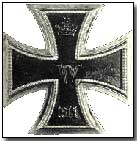Encyclopedia - Iron Cross
 The Iron Cross - perhaps
the best-known of German medals with the possible exception of the Blue Max
(Pour le Merite)
- was instituted on 10 March 1813 by King Frederick William III of Prussia
during the War of Liberation against the French under Napoleon.
The Iron Cross - perhaps
the best-known of German medals with the possible exception of the Blue Max
(Pour le Merite)
- was instituted on 10 March 1813 by King Frederick William III of Prussia
during the War of Liberation against the French under Napoleon.
The medal (in German 'Eiserne Kreuz') was reinstituted during the Franco-Prussian War of 1870-71 and again by Kaiser Wilhelm II on 5 August 1914 for use during the First World War.
The medal was awarded to recognise acts of heroism, bravery and leadership. In spite of its evident prestige it was a widely issued medal: almost six million were awarded during wartime, although by far the majority of these (5,500,000) were awarded to the lowest of three classes of the medal, the Iron Cross (Second Class).
Above this the Iron Cross (First Class) was issued to approximately 220,000 men; just five men were awarded the highest form of the Iron Cross, the Grand Cross (the Kaiser himself, Paul von Hindenburg, Erich Ludendorff, Prince Leopold of Bavaria and August von Mackensen). Hindenburg was subsequently awarded (during the German Spring Offensive of 1918) the only issued Star to the medal.
A blackened iron cross with a silver trim and a spray of oak leaves in the centre the medal was originally designed by Karl Friedrich Schinkel. The imperial crown featured at the top of the medal and the date '1914' on the bottom. The First Class medal was pinned to the tunic and the Second Class on the breast from a black ribbon with white stripes.
The medal was once again reinstituted by Adolf Hitler on 1 September 1939 in readiness for the Second World War; Hitler had himself received the award during the First World War.
A 'Base Rat' was a soldier perpetually at the base, typically in conditions of comfort and safety.
- Did you know?
